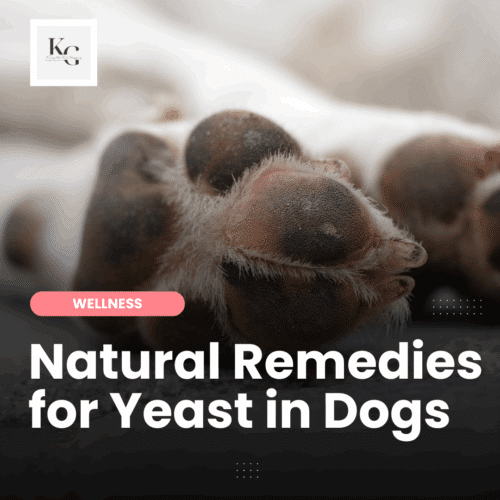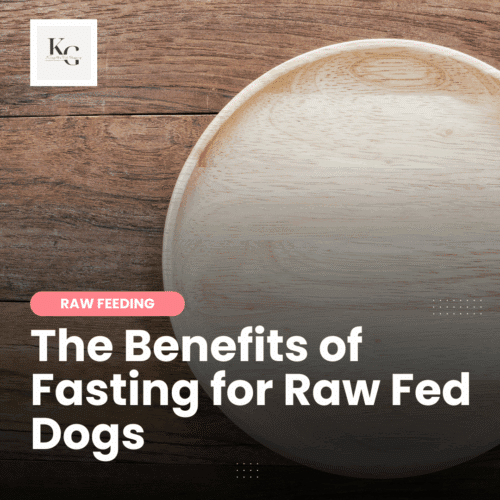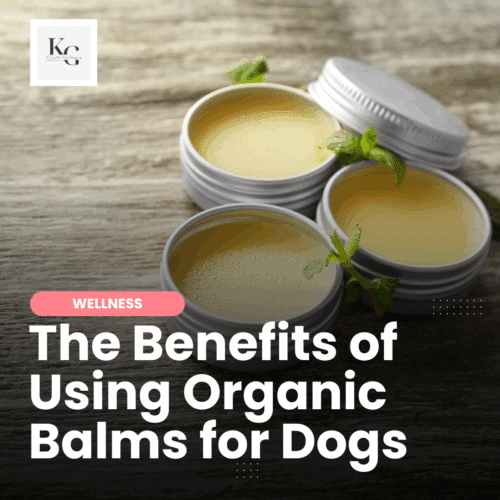Keep the Tail Wagging is supported by pet parents. I occasionally earn a commission (at no additional cost to you) when you click through an affiliate link to one of my favorite products. Thank you for your support. Read More
In Traditional Chinese Medicine (TCM), food is not simply fuel—it's medicine. TCM emphasizes food energetics, which refers to the inherent energetic qualities of ingredients and their influence on the body's internal balance. This ancient approach doesn’t count calories or carbs; instead, it looks at the warming or cooling effects of food on the body, using this knowledge to support vitality and restore harmony. When it comes to our dogs, applying these principles can help prevent or alleviate discomfort, support seasonal health, and even manage chronic issues.
What Is Food Energetics?
In TCM, every food item is categorized by its energetic temperature: cooling, neutral, warming, or hot. These are not literal temperatures, but rather how the food affects the body’s internal energy, known as Qi.
- Cooling foods help clear heat, reduce inflammation, and calm excess energy.
- Warming foods stimulate digestion, boost circulation, and improve energy.
- Neutral foods support balance and are generally safe for most dogs year-round.
- Hot foods strongly warm the body and should be used sparingly, especially in dogs already showing signs of internal heat.
Signs of a “Hot” Dog (Excess Yang)
A dog with too much internal heat may show:
- Excessive panting, especially when not hot
- Red tongue, red gums
- Dry, itchy skin or hot spots
- Restlessness or aggression
- Warm to the touch, especially paws or ears
- Seeking cool places to lie down
- Loose, smelly stools
Tip: These dogs benefit from cooling and neutral foods.
Signs of a “Cold” Dog (Excess Yin or Yang Deficiency)
A dog with internal coldness may show:
- Lethargy or low energy
- Preference for warm places (like lying on heat vents)
- Cold ears, paws, or nose
- Slow digestion or gas
- Pale tongue or gums
- Aversion to cold weather
- Joint stiffness, especially in the winter
Tip: These dogs benefit from warming and neutral foods.
Cooling Proteins, Veggies & Herbs
Use for “hot” dogs or in summer to dispel excess heat and inflammation.
Proteins:
- Duck
- Rabbit
- Turkey (some say cooling; others consider neutral to warming)
- Whitefish (e.g., cod, pollock)
Vegetables:
- Broccoli
- Celery
- Cucumber
- Kale
- Lettuce
- Spinach
- Watercress
- Zucchini
Herbs:
- Burdock root
- Cilantro
- Dandelion
- Mint
Neutral Proteins, Veggies & Herbs
Safe for most dogs and seasons. These promote balance and are ideal for maintenance.
Proteins:
- Beef (some say mildly warming; others consider it neutral)
- Bison
- Eggs
- Pork
- Turkey (some say cooling; others consider neutral to warming)
Vegetables:
- Carrots
- Green beans
- Mushrooms
- Peas
- Pumpkin
- Squash
- Sweet potato
Herbs:
- Alfalfa
- Astragalus
- Basil
- Nettle
Warming Proteins, Veggies & Herbs
Use for “cold” dogs or in colder seasons to promote energy and heat.
Proteins:
- Chicken
- Goat
- Salmon (some consider warming)
- Turkey (some say cooling; others consider neutral to warming)
Vegetables:
- Garlic (in moderation)
- Ginger root
- Parsnips
- Mustard greens
- Turnips
Herbs:
- Cinnamon
- Ginger
- Fennel
- Rosemary
Hot Foods (Use with Caution)
These are especially warming and should be used only when trying to expel deep cold or in extremely cold environments.
Proteins:
- Lamb
- Trout
- Venison
- Game meats (e.g., elk, boar)
Spices/Herbs:
- Black pepper
- Cayenne
- Clove
- Turmeric (golden paste)
Note: Hot foods are rarely needed in a dog’s diet and can easily create imbalance if overused.
Seasonal Feeding in TCM
Although I don't follow all the tenets of food energetics, I do take care when I feed certain proteins to my dogs. For example, I don't feed “hot” proteins on hot summer days. But this isn't what people mean when discussing “seasonal feeding.” TCM also teaches that diets should shift with the seasons to support the body’s adaptation to external environments.
Spring
- Focus: Liver health and renewal
- Use: Light, detoxifying foods like leafy greens, dandelion, rabbit, and duck
- Avoid: Heavy, greasy, overly rich meals
Summer
- Focus: Cooling and hydrating
- Use: Cooling proteins like duck and fish; veggies like cucumber, spinach, and zucchini
- Avoid: Hot proteins like lamb, venison, and mutton
Autumn
- Focus: Lungs and immunity
- Use: Neutral, moistening foods like pumpkin, pork, mushrooms, and pears (peeled and cooked)
- Avoid: Dry, overly spicy foods
Winter
- Focus: Kidney and warmth
- Use: Warming foods like lamb, venison, root veggies, garlic, and ginger
- Avoid: Excess cooling foods or raw meals (especially for older or frail dogs)
Feeding for Individual Balance
Food energetics provides a framework for feeding our dogs based on their individual characteristics, current experiences, and the season. Whether your dog is aging and feeling chilly, or young and bursting with fiery energy, you can use food to bring them back into balance gently.
This article only serves as an introduction to food energetics. As always, it’s wise to work with a holistic vet or Traditional Chinese Veterinary Medicine (TCVM) practitioner for personalized guidance, especially if your dog has underlying health issues.
Resources on Food Energetics
My favorite resource is Yin & Yang Nutrition for Dogs by Dr. Judy Morgan, available on Amazon. I also have a food energetics chart in my kitchen that I reference. And in 2025, Rita Hogan, The Canine Herbalist, published The Herbal Dog, which features an extensive section listing the classification of proteins, vegetation, and herbs.
- Herbsmith Inc. Food and Dietary Charts
- Helping Allergies In Dogs With Food Energetics, Dogs Naturally Magazine
- Feeding Your Pet from the Perspective of Chinese Medicine, Dr. Patrick Mahaney
- The Yin & Yang of Pet Food: Preventing pet disease with Traditional Chinese Medicine, The Honest Kitchen
- TCVM Energetically Cooling Dog Food Recipe: Food Therapy Backed by Veterinarians, Becki Baumgartner for Pet|TAO
- Feeding your dog from a TCVM perspective, Dr. Judy Morgan for Animal Wellness Magazine







Interesting article, never knew about warming and cooling foods only all the controversy over organic and plant based diets. However, I do believe in acupuncture because I have heard about all the wonderful benefits for animals. I have also had good results with it myself.
Carna4,,,,non extruded,,,,gently baked,,,,,vitamins and minerals etc come from organic sprouted seeds,,,,exceed the Aaafco standards,,,,,no I don’t work for them,,,,and yes raw is best,,,,but,,,,one thing tho,,,,,I grind the kibble first and add liquid to right consistencency,,,,and then,,,,shhhhh,,,,,I add some raw kangaroo meat from Natural Instincts. I’ve preached for years that one doesn’t mix raw and kibble but I’m hoping grinding and letting the powder soak up all the liquid plus the better quality of this kibble will soothe my conscience. My toy dogs weren’t gaining weight on a straight raw diet,,,,anyway,,,,check out CARNA4,,,,if you need a break from raw or……..whatever.
Hi Helen
I’m not an expert in food energetics; I just find it interesting. For recommendations, I recommend working with a veterinarian who practices Chinese medicine. That’s where I get my information from.
Hi,
I believe in TCM but so far have only applied it to myself. I would also like my dog to benefit from a TCM based diet. He has been suffering from constipation on and off for nearly 6 months. I have changed his dog food brand couple of times. Also, I have put him on cooked white rice, chicken and vegetables meal. It seems nothing helps. He was constipated again over the weekend to the point we had to administer enema.
Do you have any recommendations on what I should feed him? I understand that constipation is due to excess internal heat. He is also quite aggressive around strangers and other dogs. Can I say that he is more of a “hot” dog than a cool dog?
Any thoughts would be greatly appreciated because I really don’t want him to be on kibbles if possible.
Thank you.
Heidi,
I have 3 shih tzus I feed All Provide it can be purchased in a gently cooked or raw formula. You will be able to read every ingredient on the bag, no mystery stuff in this food.
For us Turkey definitely a warming food! We switched away and poop problem
cleared up……everywhere you hear it recommended as a bland food .
Not so much!
I have a Shih Tzu and my dog is on Zignature canned whitefish it’s grain free no chicken or potatoes and she does great on it.
I have been told by my holistic vet, and confirmed by another source, that kangaroo is a NEUTRAL food. (Here we go again, right?)Have to go with somebody’s advice, so I go with my vet, who is amazing.
Hi, have you considered feeding your dog a raw food or homecooked diet? That is the only way that you’ll be able to control the ingredients. You can learn more about raw feeding here: https://keepthetailwagging.com/rawfooddiet/
I can’t find a kibble with cooling foods in it for my dog it has a lot of other things in it not sure if they are cooling food do you recombed a food
Is peas and pea flour a cooling food items?
I treat emu as a hot or warming food.
I’m trying to find out about emu. Is it hot/warm/cooling?
I feel your pain Ann, It all gets rather murky. I had my dog on a raw diet which was great, and then he just completely quit eating and throwing it up. So now he is back on kibble and doing really well, but now I am reading that the lamb is a warm food. He is doing really well and I hate to mess with it because I have been dealing with food issues since I brought him home and it is really challenging.
Hi Ann
Unless a veterinarian has instructed you to start following the warming/cooling chart, I wouldn’t stress out over this. When feeding raw, it makes our dogs’ gut so much healthier that we can safely try any protein. If it doesn’t work for our dog, then we scratch it off the list. According to all of the information – Rodrigo is a hot dog and shouldn’t be able to eat lamb or venison, both hot proteins. He does great on those proteins.
Also, kangaroo is hot, I checked with a canine nutritionist in Australia.
I am soooo confused. The more I search the worst it gets. I am told kangaroo is cooling protein so I fed my dog on that.then one site says its not and to feed lamb.now i read lamb is warm. Then there’s turkey. One says its hot, the other site says its warm! What should i do? I have been buying so many different meat.
Which site to follow??
I have a Shih Tzu. he’s a very picky eater right now he’s on Earthborn coastal but i’m concerned about the protein level it’s 32% and he’s not real active. he use to be on Fromm Pork and applesauce i’m thinking i might go back. Does anyone have a Shih Tzu or small breed similar that has good food? i usually do the grain free with him.
While Nature’s Logic may not use premade mixes from China, it’s still a kibble which isn’t species appropriate for dogs and ultimately leads to poor health, compromised digestive and immune systems, a chronic state of dehydration, joint issues (because kibble is an inflammatory), and more. I understand that dogs have been eating kibble for years, however, it’s not an ideal diet and something that I no longer recommend to anyone if they want to raise a happy, healthy dog. Please watch the movie Pet Fooled.
Hi, Janie! You are right on target about the Chinese premix issue. Because of it, several years ago, I did some pretty extensive research about which commercial dog foods did not use ANY Chinese premix in their formulas and unfortunately, there were very few. I DID, however, find the Nature’s Logic line of pet foods that have an excellent track record with a variety of pet food advisors AND they don’t use Chinese premix as a source of vitamins and minerals. Instead, all of their nutrients come from natural plant and animal sources. I switched my critters (dogs and cats) to Nature’s Logic that very day and they are still doing great on it! I love that the line has a wide variety of single-source proteins to choose from so if your dog/cat has an allergy to one type of protein, it’s easy to switch to another. Don’t mean to sound like a commercial here, but I really love this line and recommend it highly to anyone looking to avoid feeding their pets foods with the Chinese pre-mix! 🙂
🙂 HOT
My dog is highly sensitive to food and he doesn’t react the same way to goat as he does with lamb, so I’ve always considered goat to be warming or neutral and lamb to be warming or hot. Turkey is definitely warming. I know that these charts are just a starting point and that each of our dogs are different; plus more goes into allergies than the temperature of the food.
According to Herbsmith’s Food Chart, Hot proteins include lamb, mutton (sheep), sheep’s liver, and venison. I don’t like to assume anything, but in this case I would ere on the side of saying goat is either a warming or hot protein considering the similarity between goats and sheep.
Also, their chart lists turkey as a warming protein, although I’ve seen listed under cooling on other charts.
I too need to know about goat. My Westie eats Sojo’s goat, and I need to know, if it is a warming or cooling food.
I’m not sure. I’ve been searching for goat, emu, and alpaca for months.
Hi Kimberley – where does goat fit in with raw fed dogs – warming?
Great question. Because Rodrigo has a tough time eating turkey, I would put it in the Warming Food category.
I am finding the same problem with how to define turkey. What were your findings when you removed it from the diet?
I need to know where goat and emu fall on the Hot/Cool/Warm/Moist list.
I enjoyed your article. I love learning about the different proteins. Thank you for posting
Thank you for letting me know about kangaroo. I like to change their protein and thought kangaroo would be good. I will not go that route. I need cooling/neutral foods. Thank you again for your help.
I don’t know where brushtail fall on the Hot/Cold/Neutral list. Kangaroo, however, falls on the Hot/Warm list.
Thanks for simplifying this issue of what is hot and cool. I am looking at alternative meats, such as kangaroo and brushtail(Austrailian “possum”). Would you know if those are warming or cooling. The descriptions you gave helped me figure out which foods to give to my dogs that would be beneficial to both since they are opposite.
Hi Tobey
I don’t sell food. I’d recommend visiting your local pet store (not Petco or PetSmart) and working with a holistic vet with experience in Chinese medicine on your dog’s diet. My vet has been really crucial in getting our dogs’ diets right.
Best of luck.
Kimberly
Hello —
I am looking at putting my GS on a diet with Cooling Foods. I am wondering if there is a good product available to purchase. If not, how much should I feed him each day? He is about 100 pounds. Thank you!
Hi Kimberly-
I am crazy about raw food so that’s why I STRONGLY recommend it. I discuss more crazy stuff that goes on in the pet industry. Awareness is important. :o)
Thank you so much, Janie! I had no idea about where the premix is sourced. Thank you.
This issue I have with kibble is that most of the vitamin premix is sourced from China. Vitamin premix is the mixture of vitamins & minerals which show up on the label of dog food. After kibble is cooked at such high temperatures and then processed further, it leaves the product void of nutrients. Premix is added. China’s premix product is problematic because it is contaminated with melamine. The FDA lead us to believe that salmonella is an issue. They discovered that it is the melamine that is making dogs ill and killing them. Raw food should not a problem for dogs with healthy immune systems. Approximately 30% of dogs already carry salmonella in their systems. It is natural for them. I have written EXTENSIVELY on this subject on my website essentiallydogs.com. Just use the little search bar and type in keywords like China, salmonella, FDA, and raw.
Yeah, turkey is definitely one on which experts don’t seem to be able to agree.
I know. I’ve asked so many people about Turkey and everyone has a different answer.
Fabulous!
This is so good. I only know human have hot and cold.
Thanks.
I know I told you previously that I needed to research these things. Well…I still haven’t, so this post is super helpful to me. Thank you!
The TCVM properties of food is one of my fascinations. It’s kind of interesting that not everybody agrees on the properties of some of the foods, though.